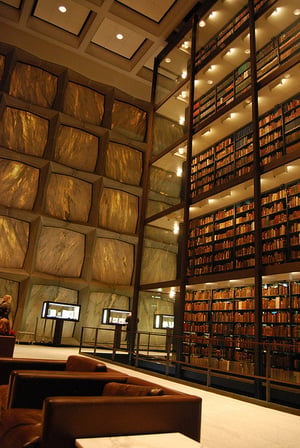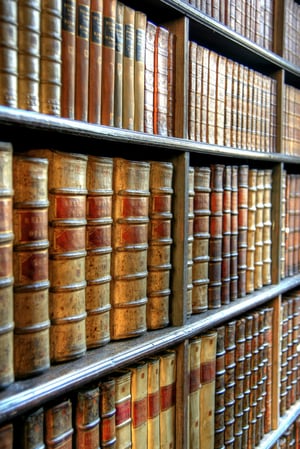Whether you’re an academic researcher, an archivist, or simply someone who has an interest in rare books, you should visit the Beinecke Rare Books and Manuscripts Library at least once in your life. While the collections at the Beinecke, like those within other special collections libraries, are open only to researchers, there’s still a lot to see even if you’re just passing through New Haven, Connecticut on a weekday afternoon. Indeed, the Beinecke keeps a variety of items from its collection on display within its incredible building at Yale University. And don’t get discouraged by the idea that you need to be a researcher in order to view any of the collections. While academics certainly visit the Beinecke with frequency, researchers do not have to be affiliated with a college or university to access the collections. To be sure, researchers come from a variety of backgrounds to engage in work related to the papers held at the library.
Book Exhibitions at the Beinecke

If you only have a short time in New Haven and don’t have a research agenda at the Beinecke Rare Books and Manuscripts Library, you can still stop in and enjoy some of the treasures from the collection. The ground floor and mezzanine areas of the library contain permanent and special exhibitions. Two particular items from the Beinecke’s collection are on permanent exhibition: The Gutenberg Bible, which the Beinecke describes as “the first Western book printed from movable type,” and Johns James Audobon’s Birds of America. You can see both books on the mezzanine level. The ground floor also contains some items in the Beinecke’s permanent collection, including a selection of incunabla, “the earliest printed books in the West, from 1455 to ca. 1500.”
Beyond these objects, the library also has various special exhibitions with items from its collection. Recent special exhibitions include “Bibliomania; or Book Madness: A Bibliographical Romance” and “Beyond Words: Experimental Poetry & the Avant-Garde.” In the “Bibliomania” exhibition, visitors to the Beinecke could view objects from four “case studies” in bibliomania, including the collection of the “legendary nineteenth-century bibliomaniac Thomas Phillipps” who, according to the Beinecke, had an entire English country house filled with his “vast collection of manuscripts and early printed books.” This special exhibition included a partnership with the Harry Ransom Center at the University of Texas, Austin. The “Experimental Poetry” exhibition took visitors to the library through colorful books, pamphlets, broadsides, and other objects used to create avant-garde poetry across Europe, the Americas and Asia during the earlier portion of the twentieth century.
New Acquisitions in the Beinecke’s Collection
Like other special collections libraries, the Beinecke is always acquiring new collections. Depending on when you visit, you might find new acquisitions that include the papers of a single writer or artist, or an exciting collection that brings together books and ephemera from across the globe. Two recent acquisitions include a collection of collages by the poet John Ashbery, and the papers of Mei-mei Berrsenbrugge.
The John Ashbery collages were created largely over the poet’s lifetime, spanning in time from 1948 (when Ashbery was only 21 years old) up until 2011, just a handful of years before his death in 2017. As for the papers of Mei-mei Berrsenbrugge, researchers are really in for a treat. As a poet and teacher, Berrsenbrugge has collaborated with notable visual artists such as Kiki Smith and Richard Tuttle, and has corresponded with a wide variety of twentieth- and twenty-first-century figures like John Ashbery, Joy Harjo, and Arthur Sze.
Digital Access to the Beinecke

Beyond visiting the Beinecke in person, there are also ways to engage with this special collections library from the comfort of your own home. The Beinecke has certain collections available digitally, including medieval manuscripts and materials from the James Weldon Johnson Collections. Most of the digital material is completely open to the public. There are also digital exhibitions that are accessible to online users. From your own armchair and laptop computer, you can view portraits taken by the book editor Arthur W. Wang, early modern study aids, and materials from “American utopias,” which the Beinecke describes as documents ranging from “the first Puritan settlements to the communes of the 1960s.”
In addition to digital access to items in the Beinecke collection, you can also learn more about the Beinecke through technology. Indeed, the library has a podcast series! The Beinecke Illuminated Visual Podcasts give listeners a way to connect with the Beinecke even when you’re not in front of a computer screen. With access on Soundcloud and other podcast platforms, you can download the podcasts to your phone or other device and listen with or without internet access.
We’ve only scratched the surface of the materials available at the Beinecke Library, and we encourage you to plan a visit to New Haven to see for yourself what the Beinecke has to offer.









